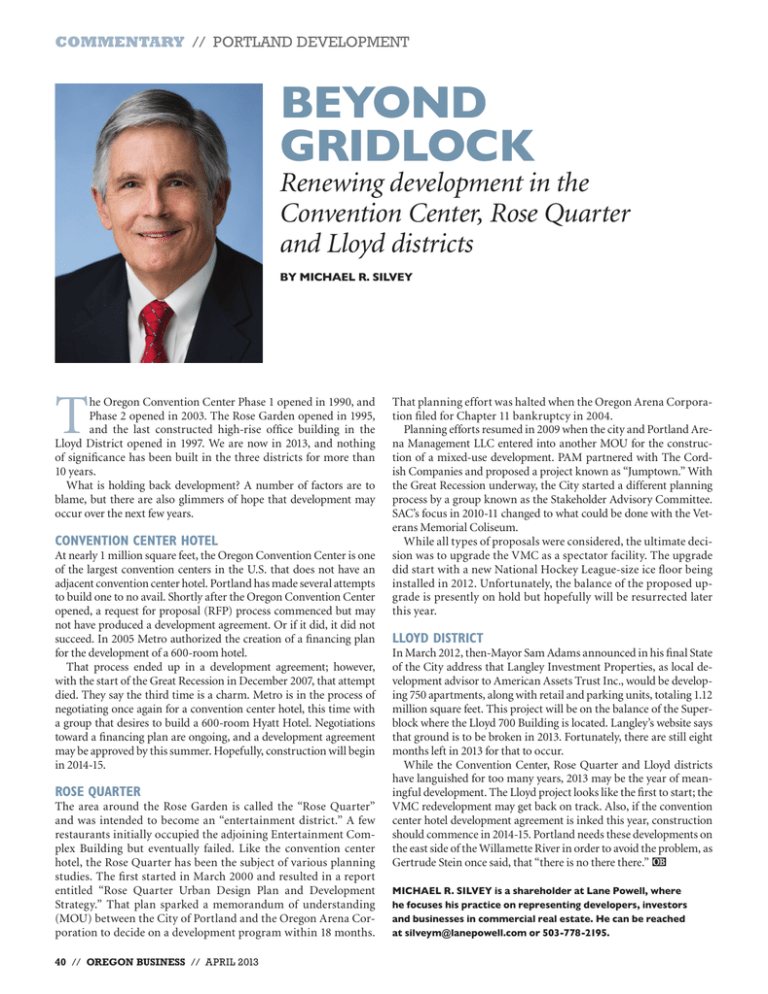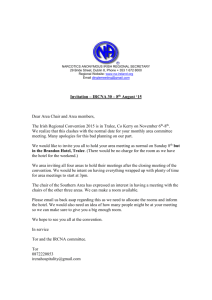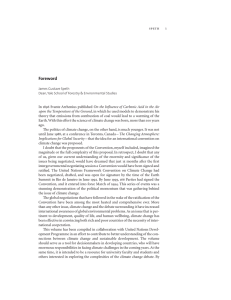T COMMENTARY // PoRtLAnd deveLoPment
advertisement

COMMENTARY // Portland development beyond gridlock Renewing development in the Convention Center, Rose Quarter and Lloyd districts BY Michael R. Silvey T he Oregon Convention Center Phase 1 opened in 1990, and Phase 2 opened in 2003. The Rose Garden opened in 1995, and the last constructed high-rise office building in the Lloyd District opened in 1997. We are now in 2013, and nothing of significance has been built in the three districts for more than 10 years. What is holding back development? A number of factors are to blame, but there are also glimmers of hope that development may occur over the next few years. Convention Center Hotel At nearly 1 million square feet, the Oregon Convention Center is one of the largest convention centers in the U.S. that does not have an adjacent convention center hotel. Portland has made several attempts to build one to no avail. Shortly after the Oregon Convention Center opened, a request for proposal (RFP) process commenced but may not have produced a development agreement. Or if it did, it did not succeed. In 2005 Metro authorized the creation of a financing plan for the development of a 600-room hotel. That process ended up in a development agreement; however, with the start of the Great Recession in December 2007, that attempt died. They say the third time is a charm. Metro is in the process of negotiating once again for a convention center hotel, this time with a group that desires to build a 600-room Hyatt Hotel. Negotiations toward a financing plan are ongoing, and a development agreement may be approved by this summer. Hopefully, construction will begin in 2014-15. Rose Quarter The area around the Rose Garden is called the “Rose Quarter” and was intended to become an “entertainment district.” A few restaurants initially occupied the adjoining Entertainment Complex Building but eventually failed. Like the convention center hotel, the Rose Quarter has been the subject of various planning studies. The first started in March 2000 and resulted in a report entitled “Rose Quarter Urban Design Plan and Development Strategy.” That plan sparked a memorandum of understanding (MOU) between the City of Portland and the Oregon Arena Corporation to decide on a development program within 18 months. 40 // Oregon Business // APRIL 2013 That planning effort was halted when the Oregon Arena Corporation filed for Chapter 11 bankruptcy in 2004. Planning efforts resumed in 2009 when the city and Portland Arena Management LLC entered into another MOU for the construction of a mixed-use development. PAM partnered with The Cordish Companies and proposed a project known as “Jumptown.” With the Great Recession underway, the City started a different planning process by a group known as the Stakeholder Advisory Committee. SAC’s focus in 2010-11 changed to what could be done with the Veterans Memorial Coliseum. While all types of proposals were considered, the ultimate decision was to upgrade the VMC as a spectator facility. The upgrade did start with a new National Hockey League-size ice floor being installed in 2012. Unfortunately, the balance of the proposed upgrade is presently on hold but hopefully will be resurrected later this year. Lloyd District In March 2012, then-Mayor Sam Adams announced in his final State of the City address that Langley Investment Properties, as local development advisor to American Assets Trust Inc., would be developing 750 apartments, along with retail and parking units, totaling 1.12 million square feet. This project will be on the balance of the Superblock where the Lloyd 700 Building is located. Langley’s website says that ground is to be broken in 2013. Fortunately, there are still eight months left in 2013 for that to occur. While the Convention Center, Rose Quarter and Lloyd districts have languished for too many years, 2013 may be the year of meaningful development. The Lloyd project looks like the first to start; the VMC redevelopment may get back on track. Also, if the convention center hotel development agreement is inked this year, construction should commence in 2014-15. Portland needs these developments on the east side of the Willamette River in order to avoid the problem, as Gertrude Stein once said, that “there is no there there.” Michael R. Silvey is a shareholder at Lane Powell, where he focuses his practice on representing developers, investors and businesses in commercial real estate. He can be reached at silveym@lanepowell.com or 503-778-2195.




